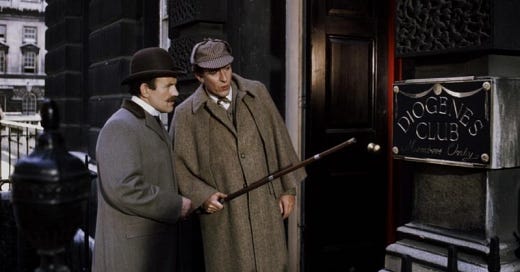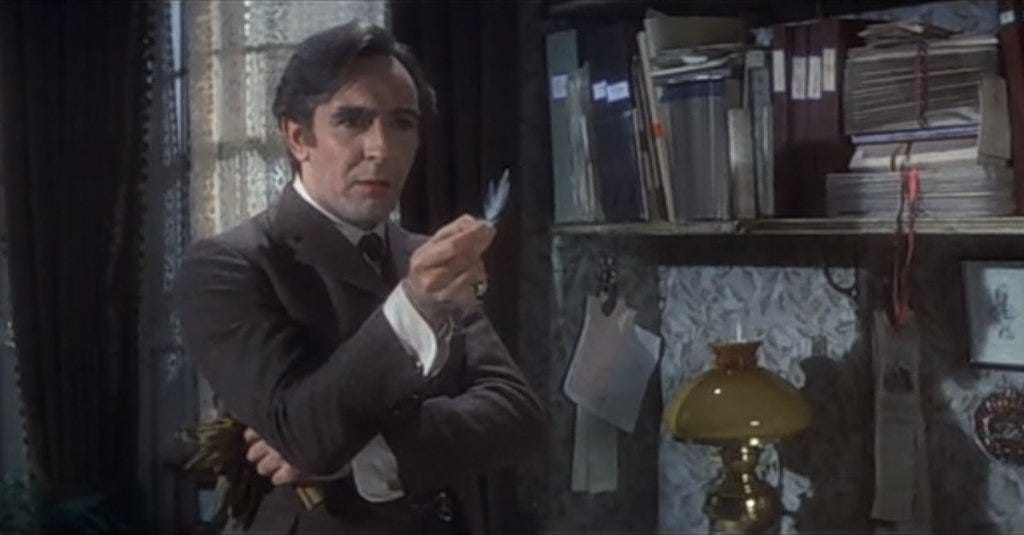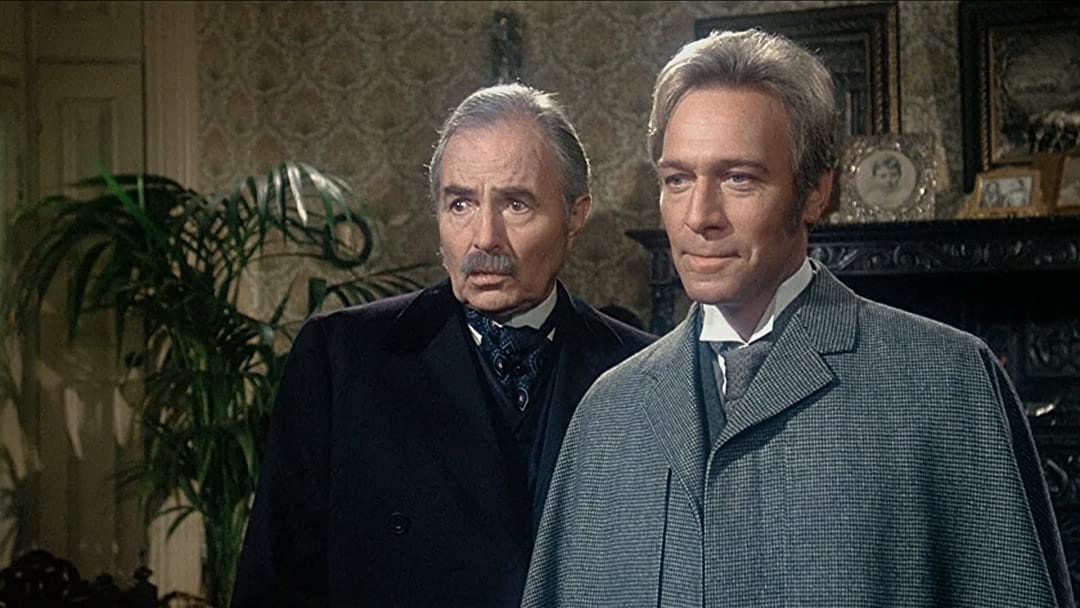Under the Magnifying Glass: The Adventures of Sherlock Holmes in ’70s Cinema
In the 1970s, four films attempted to reinvent Sherlock Holmes in ways that reflected the times around them.
When Arthur Conan Doyle first killed Sherlock Holmes, the action had unforeseen consequences. The prolific writer and physician first introduced Holmes in the 1887 novel A Study in Scarlet with little immediate impact. But reviving the character—first in the 1890 novel The Sign of the Four, then in a series of 24 short stories published in The Strand in a productive rush between 1891 and 1893—had changed that, making a famous man of Doyle but an even more famous man of Holmes and his companion and biographer Dr. Watson. Still, by the end of that run, Doyle had had enough, sending Holmes and his archenemy Professor Moriarty over the Reichenbach Falls. And that was that.
Or it might have been, if not for a public outcry. Doyle received angry letters and The Strand lost, if a much-reported figure is to be believed, 20,000 subscribers. (Stories of Holmes fans, back before the term “fan” was in wide circulation, wearing black armbands in protest seem to be apocryphal.) Doyle stuck by his decisions for years before bringing Holmes back from the dead around the turn of the century, after which the detective embarked on many more adventures. But his readers’ shock at his disappearance during what’s now known as The Great Hiatus is telling. He wasn’t so much missed as needed.
Using deductive reasoning that suggested no problem was beyond the ability of human intelligence, Holmes was a sure man in unsure times as a new century loomed and Britain began to feel the weight and limitations of its Empire. (And, simultaneously, the streets of London filled with horse dung and urine.) To paraphrase a later detective’s chronicler, sometimes there’s a man who’s the man for his time and place. He fits right in there.
Holmes, of course, didn’t fade when that time passed. His adventures have been adapted and revisited again and again and other creators have run with Doyle’s creation in the lively field of extra-canonical Holmes pastiches. During this time, a set idea of Holmes developed, largely thanks to a string of popular movies starring Basil Rathbone as the great detective. But set ideas have a way of growing dull, particularly in cultural moments interested in upturning the established order. And just as traditional westerns gave way to the psychological westerns of the 1950s and the spaghetti and revisionist westerns of the ’60s and ’70s, Holmes found himself in the hands of creators interested in taking him apart and seeing how he worked in a series of 1970s films.
The very title of Billy Wilder’s The Private Life of Sherlock Holmes suggests a radical departure from the Holmes of tradition. Doyle constructs Holmes’ personality largely through intriguing details: his untidy living arrangements, his “aversion to women” (in Watson’s words), his seeming lack of emotion, his fondness for the violin, his cocaine use. Wilder’s film, co-written with I.A.L. Diamond, builds on these details to create a Holmes whose eccentricities suggest a fragile character. Then, in the end, they break him.
As played by Robert Stephens, Holmes uses cocaine to fight the terrifying boredom that overtakes him between cases. He’s complex and troubled in other ways as well. The film’s first and lightest section finds him fending off the advances of a retiring ballerina (Tamara Toumanova) who wants him to father a child with her in the hopes the kid will inherit Holmes’ best qualities. Holmes demures, suggesting he’s in a relationship with Watson (Colin Blakely). The film plays this for laughs, but when asked by Watson about what, if any, relationship Holmes has with women, his friend remains cagey and evasive.
The moment suggests much and confirms nothing and that’s part of why the movie works so well. (Stephens’ strong performance doesn’t hurt, either.) Wilder pulls back the veil on Holmes, but only a little bit. He’s less concerned with revealing what makes Holmes tick than in making viewers rethink what they already know about the character. He’s also interested in pushing Holmes to his limits. The bulk of the film’s running time is consumed with the story of a mysterious woman named Gabrielle (Geneviève Page) pulled from the Thames and deposited in Holmes’ and Watson’s apartment, her presence only accenting Holmes discomfort with women. Without spoiling what follows, Gabrielle’s plight draws him into an intrigue deeply connected to the troubles of the century to come. In the end, a demoralized Holmes can do nothing but retreat to his room, cocaine in hand, unprepared for what’s to come.
The film itself, as we now know it, is more than a little broken, too. Designed to be episodic, and long, its original running time stretched past the three-hour mark. When screenings didn’t go well, three complete mysteries were cut and largely lost (though some exist in part and can be found on a Blu-ray edition I’m currently waiting to arrive from the U.K.). Years later, Wilder would warn Cameron Crowe against making episodic movies because it was too easy just to excise whole episodes. But what survives is remarkable. Wilder was a Holmes enthusiast and it’s the sort of movie that could only be made by somebody who’d thought long and deep about the hero and wasn’t entirely comfortable with where those thoughts took him.
Though a flop when it arrived in American theaters in 1971, Wilder’s film didn’t kill interest in new takes on Holmes. (As Doyle discovered first, he’s hard to kill.) In 1975, Gene Wilder made his directorial debut with The Adventures of Sherlock Holmes’ Smarter Brother, a film that only rarely finds a second joke to go with the concept spelled out in the title. Wilder plays Sigerson Holmes, Sherlock’s previously unmentioned younger brother, who becomes a pawn in a case Sherlock (Douglas Wilmer) is investigating. Madeline Kahn co-stars as a woman who’s not quite what she seems, alongside Marty Feldman as a lowly Scotland Yard employee who becomes a kind of Watson to Sigerson.
Much of the film exists on the borderlands of humor but struggles to cross over. A fight between Sigerson and a Moriarty henchman played by Roy Kinnear involving the oversized body parts found on the signs of various London shops is one of many funny-in-theory moments, though the film picks up in a climax featuring Dom DeLuise as an Italian opera singer and a faux-Verdi production that draws on Kahn’s opera training and features lines like “Why don't we all drink-a some very sexy wine?”
Much better, and much more invested in the Holmes mythos, is the following year’s The Seven-Percent Solution. Directed by Herbert Ross from a script by Nicholas Meyer adapting his 1974 novel of the same name, it’s driven by some of the same impulses as The Private Life of Sherlock Holmes but channels them into a crowd-pleasing adventure. Here Holmes (an excellent Nicol Williamson) is an addict in thrall to delusions from a traumatic childhood incident. But he’s also a hero who finds a way out of his troubles thanks to the guidance of an expert on troubled psychology: no less than Sigmund Freud (Alan Arkin) himself.
The film deconstructs the Holmes mythos, only to rebuild it from the same parts. Sure, Watson (Robert Duvall, not the most obvious actor for the part but not bad) is correct that Holmes’ obsession with Moriarty (played meekly by Laurence Olivier) is misplaced. Holmes might be troubled but he remains a brilliant detective when his head is clear and his energies channeled in the right direction. Here that involves pursuing a kidnapping case through the streets of Vienna with Freud serving as a second sidekick alongside Watson. The film acknowledges some of the darkness at the heart of Doyle’s creation, but also offers a way out of that darkness through therapy and self-exploration. He’s the most 1970s Sherlock Holmes ’70s movies had to offer.
He wasn’t, however, the decade’s final cinematic Holmes. That honor would go to Christopher Plummer in Bob Clark’s 1979 Murder by Decree, which put Holmes on the trail of a famous contemporary: Jack the Ripper. The film wasn’t the first Holmes story to pit the two against each other. John Neville’s Holmes did battle with him in the 1965 film A Study in Terror. And it wouldn’t be the last, thanks to the 2009 Lyndsay Faye novel Dust and Shadow. But in some respects, it stands apart from the others because the enemy is ultimately revealed to be bigger than a single serial killer ever could be.
Working from a script from John Hopkins, Clark is no less interested in some of the thornier edges of Holmes’ personality than his predecessor. The film puts class at its center, opening with a scene in which the theatergoers in an upper balcony jeer at Prince Edward, heir apparent to the throne of Queen Victoria. Holmes is sniffy at this and sniffier still when some Whitechapel residents plead for his help with some unsolved murders. But his investigations — conducted with the help of Watson (James Mason), of course — will undermine some of his assumptions about the true location of England’s barbarous heart. (No spoilers, but readers of Alan Moore and Eddie Campbell’s From Hell will find the story familiar since it draws on some of the same source material.)
Handsomely shot, superbly cast (with supporting roles filled by David Hemmings, Genevieve Bujold, Donald Sutherland, John Gielgud, and Susan Clark) and filled with intriguing details if a bit too stodgily paced, the film interprets Holmes as a far more emotional man than tradition has him — laughing at Watson one moment and angrily attacking an enemy the next — but the choice fits into the scheme of the film. Holmes understands the criminal mind and has survived his brushes with the London underworld of blackmailers and burglaries. This is something else.
The London of Murder by Decree looks at first like the familiar world of Holmes mysteries, but Clark takes the story to places unknown in the pages of Doyle, like seedy taverns where a streetwalker boasts of the competitive advantage of having all her teeth. In the end, Holmes can solve the mystery but do nothing about the rot his investigation uncovers. It’s a fate familiar to many of his cinematic contemporaries, his fellow Sherlocks and otherwise. He might be a 19th century man at heart, but the 1970s had plenty of room for him.









Me think Sherlock Holmes so endlessly adaptable because, while Doyle's actual stories range from fine to great, *idea* of Sherlock Holmes is all-timer. Which is why various adaptations can take things barely mentioned in books — Moriarty, Mycroft, Irene Adler, cocaine use (which medical doctor Arthur Conan Doyle seem to have confused with opiate, because in stories it put Holmes into stupor) — and flesh them out remarkably well. Not to mention plugging Holmes into Victorian London full of other romanticized figures (Jack the Ripper and Freud among them).
And Holmes formula — of impossible mystery solved by impossibly clever bloke — sturdy enough that your various Laws & Order and CSIs not can ever exhaust it. It like cookie dough — you can add chocolate chips, raisins walnuts, frosting, ice cream, whatever delicious chemical sludge they put in Oreos — it always going to be good because underlying idea just incredibly appealing.
This one may fall out of your purview since it’s an hour-long television film -- and it’s about Sherlock Holmes’s grandson, who’s also named Sherlock Holmes -- but 1977’s The Strange Case of the End of Civilization As We Know It lives up to its name. It stars and was co-written by John Cleese while he was between series of Fawlty Towers and is as much about taking the piss out of ’70s detective shows as it was playing around with Holmesiana. (For example, instead of cocaine, Cleese’s Holmes smoke marijuana.) Also, Dr. Watson’s grandson, who’s played by Arthur Lowe, has “bionic bits” for some reason that is never really clear.